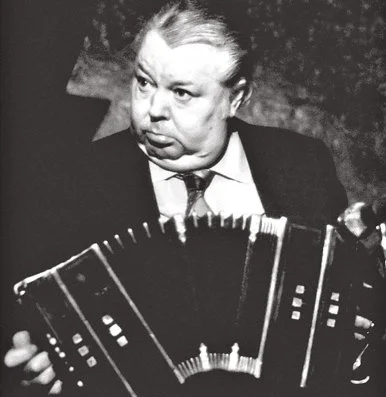The Golden Age
The "Golden Age" of tango is generally agreed to have been the period from about 1935 to 1952, roughly contemporary with the big band era in the United States. Tango was performed by orquestas típicas, bands often including over a dozen performers.
A succession of military dictatorships in Argentina contributed to a hiatus in tango dancing from the late 1950s until the return to a democratic government in the early 1980s. When the dance halls reopened, people danced to the same music they had danced to in their youth. The dance those people passed along to the next generation, is intimately connected with the Golden Era music.
You will hear recordings from earlier and later than this period, but you will always mostly hear music from the Golden Age when you go out dancing. Getting to know and understand this music, goes hand in hand with learning to dance tango.
King of the beat
Tango music can be traced back to the 1850s, but during the Guardia Nueva period, (1925-1935) Tango dancing had started to decline. The musicians began focusing less on the beat and more on the melodies as people were buying records and listening to tango on the radio. Dancing was no longer the primary concern.
Then, in the mid-1930s, Juan d'Arienzo exploded onto the scene returning to the driving beat of the Guardia Vieja (1895-1925). D'Arienzo was seen as a step backwards by many tango musicians and fans of the music, but the dancer's loved him and responded by returning to the dance floor and packing the dance salons.
D'Arienzo ushered the return of emphasizing rhythm over melody and harmony and was given the nickname, “El Rey del Compas” (King of the Beat). Though this video (above) is from later in his career - you can still see and hear the strong emphasis on the beat as he leads his Orchestra in a fantastic version of "Loca."
The hits
Other famous orchestras from the Golden Age are: Aníbal Troilo, Carlos di Sarli, Osavaldo Pugliese, Francisco Canaro, Ángel d'Agostino, Osvaldo Fresedo, Miguel Caló, Rodolfo Biagi, Lucio Demare, Edgardo Donato, Pedro Laurenz, Francisco Lomuto, Alfredo de Angelis and Enrique Rodríguez. Listen to some of their greatest hits below:
During this time, a new partnership was forged between the orchestras and the singers. Orchestra leaders figured out a way to incorporate in the singers without putting them in front and sacrificing the rhythm for dancers. Ángel d'Agostino and the singer Ángel Vargas is a good example of this relationship. Listen to their song, "Tres Esquinas" below.
In 1937, Aníbal Troilo's orchestra debuted with Francisco Fiorentino as the singer. Troilo was a large man and had the nickname "Pichuco." He was an innovator and kept pushing tango into new areas especially once he hired a young bandoneon player named Astor Piazzolla and made him arranger for his orchestra. Troilo was popular with both dancers and the listening public. To this day, his pictures are hanging all over Buenos Aires cafés and restaurants.
Listen to his song, "Tinta Roja" below.
By the mid to late 1940s, tango was at its height. There were 50 or so orchestras and countless ensembles playing around the city at salons, cafés, cabarets, confiterías and social and sports clubs. They were also playing around the country and traveling internationally.
Each district of the city had its own social and sports club such as River Plate, Huracán, Atlanta, Independiente. This is where many younger people came to learn to dance and socialize. They would also hold dances at night.
Orchestras would often play at several venus per night and their hardcore fans would follow them around from club to club.




